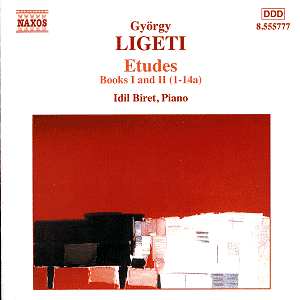The Turkish pianist Idil Biret has made some
celebrated Chopin and Brahms discs for Naxos but this disc represents
something of a departure for her. That said, Ligeti's piano Etudes
are, by and large, very much less intimidating than the composer's
general press might have led you to expect. The CD is notable
in that it includes the first recording of Book II's XIVa. It
is also slightly controversial in that Biret chose to favour the
score's musical markings over the precise timing indications when
the two came into conflict. So what can you expect if your sole
or main exposure to Ligeti is via the choral/vocal works, particularly
the (in)famous Lux Aeterna, as used in the soundtrack to
Kubrick's 2001? Well, actually, quite a lot of stimulating,
accessible and interesting music which shows influences from Chopin,
through Debussy and Satie, to Bartók, Nancarrow, jazz and
oriental music.
Book I was completed in 1985 and tends to alternate
between the faster, rhythmic (often polyrhythmic) pieces, e.g.
Fanfares, and more languid, impressionistic ones, such
as Arc-en-ciel. Occasionally harsh, this music is never
particularly difficult and anyone with much experience of any
of the aforementioned composers should not find it too alien.
The more recent Book II begins with a Balinese
gamelan inspired piece and, while not as pretty as the equivalent
Debussy works, this is absolutely not barbed-wire territory, in
terms of ease or difficulty of listening. Typically, and certainly
out of necessity in this evocation, the piano is used very much
percussively. Again, this is hardly anything new to seasoned Bartókians
or, for that matter, the growing band, myself included, of admirers
of the often brilliant and humorous player-piano music of Conlon
Nancarrow. Fém is rather more conventionally rhythmic
but melts into a touching outro. Vertige is just
that, a spinning, spiralling, dizzying four minutes and the following
Sorcerer's Apprentice is very much in a similar vein, a
great deal more fleet of foot than its Dukas orchestral namesake.
Again there is a slight oriental influence, à la Debussy,
with En suspens, in a much more reflective way, continuing
that similarity. The Devil's Ladder is the longest piece
on the disc at almost seven minutes and gathers much percussive
momentum before its portentous "Lisztian diablerie at the centre".
The two remaining pieces, including the premiere XIVa, the only
etude conceived directly for player piano, are rhythmic and percussive
tours de forces. They are fully worthy of comparison with
Nancarrow's equivalent works, bringing to a close a most stimulating
and informative disc. For those who have read about Ligeti's orchestral
works and imagined some Takemitsu-like diffuseness, this music
for piano may come as both a shock and a pleasant surprise. A
genuine bargain, with performance and production matching the
music every step of the way.
Neil Horner
